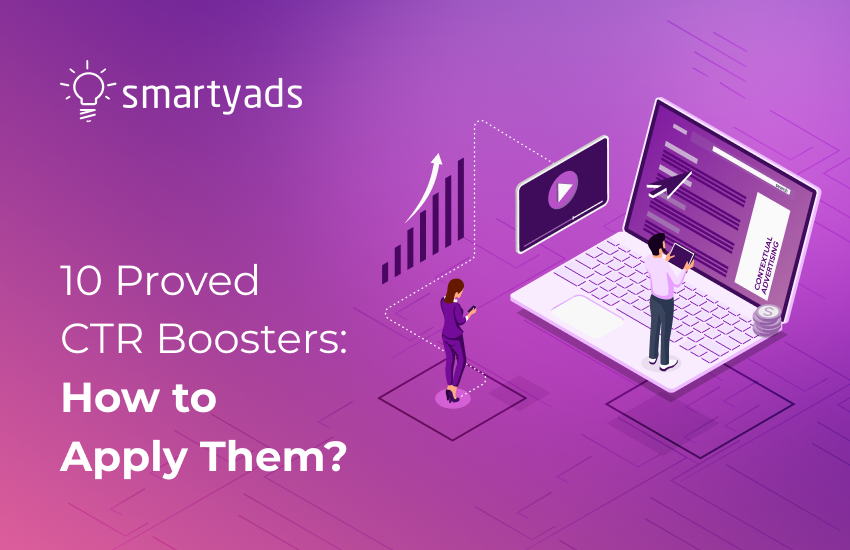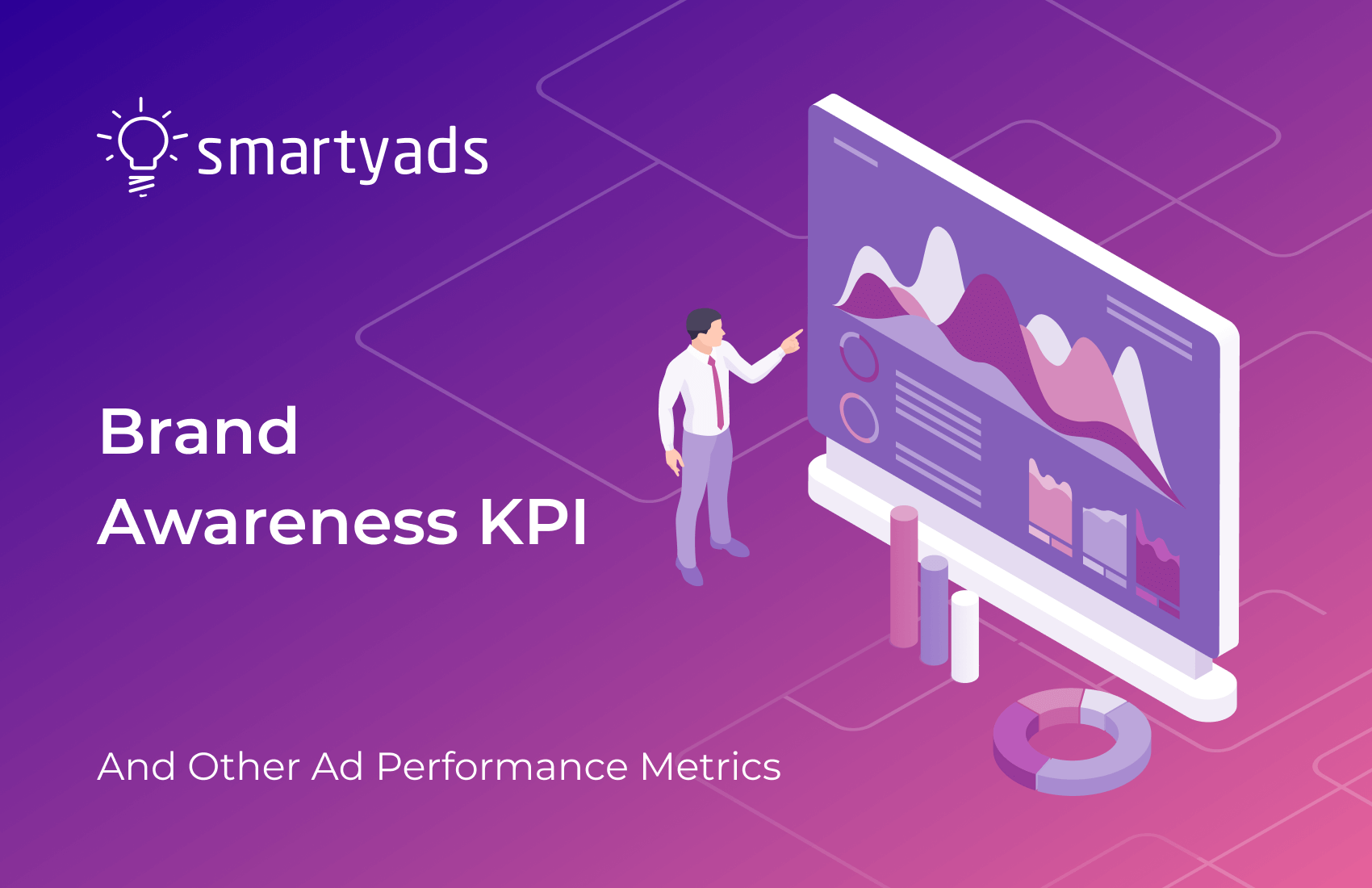Every time we set up a campaign, we can face a lingering feeling of uncertainty.
Will my audience get the message? How will this message resonate with their needs and interests? Will it turn visitors into your new customers, or will people simply ignore it? All these questions really have the same point in their essence, so the answers will depend on the same thing — campaign effectiveness.
One of the most simple and obvious ways to get answers is to count the number of interactions between the users and a particular ad. If a website visitor clicks on an ad, it means that the message is noticeable, attractive, and engaging — which is exactly what every marketer wants it to be.
Therefore, such metrics should be closely measured and improved if the results are not satisfying enough. In this article, we are going to talk about one of the most widely used metrics — CTR and the ways to improve it.
What is CTR?
CTR stands for "click-through rate"; it is one of the main indicators of campaign effectiveness. It can be defined by the number of clicks on an ad compared to the overall number of times it was shown. The click-through rate is calculated as a ratio between ad clicks and ad impressions which is then shown as a percentage.
For example, if your ad gets 1000 impressions and the users click on it 100 times, your average CTR will be 10%. Therefore, the more attractive your offer is, the higher the click-through rate it will get.
We'll discuss the most effective ways of improving CTR in the next paragraphs, and in the meantime, let us discover why this metric is important and how you can combine it with other metrics to get a full picture of your campaigns' success.

What does Click-Trough Rate reflect?
If you've been working with advertising for some time already, you might have noticed that CTR is considered one of the most classic performance metrics widely used within every business vertical.
When the users turn their attention to the ad, they usually show it by clicking on it. An engaged user can be delighted by your offer and even proceed to your call-to-action. So it seems quite natural that a campaign with higher CTR will also get higher conversion rates.
Having a good average click-through rate can give you a lot of benefits. In terms of SEO, better rates will give your landing page more credibility for search engines and, thus, better rankings.
Moreover, in some cases, if an ad gets a high CTR, it also gets lower cost-per-click, so the perks of getting good rates are even more appealing. But before we dive into investigating how to increase click-through rate, let's make it clear that this metric shouldn't be used alone to define the performance of your campaigns.
CTR reflects how appealing your message is, but to get a full picture of your campaign performance, you should also pay close attention to other metrics, more focused on conversions. It can be a number of people who contacted you or completed the form — the actual measurements will depend on your specific business goals.
The Impact of Click-Through Rate
The Click-Through Rate (CTR) serves as a critical metric in assessing the overall performance of an advertisement. This powerful indicator enables advertisers to gain valuable insights and wield control over various aspects of their campaigns.
CTR's far-reaching influence encompasses the following key areas:
Advertising Cost Control
By closely monitoring the Click-Through Rate, advertisers can gauge the effectiveness of their ad composition. A low CTR may lead to increased costs per click. This knowledge is a compass for optimizing ads and boosting Click-Through Rates within the confines of a single advertising campaign.
Be it Google Ads or any other programmatic platform, understanding and managing this metric holds the key to cost-effective advertising. A high CTR leads to lower ad costs, increased engagement, and a higher Quality Score.
Creative Testing
The versatility of CTR allows advertisers to experiment with diverse creative elements in their ad copy, such as texts, appeals, headlines, and design solutions. Tracking CTR for these variants enables astute marketers to draw conclusions about the effectiveness of different marketing techniques. This proves particularly crucial in targeted advertising tailored for narrow audience segments.
Evaluating Landing Page Effectiveness
A landing page, akin to a grand advertisement comprising graphics, text, and conversion buttons, seeks to entice clicks. In this realm, CTR reigns supreme as the primary indicator of effectiveness. Understanding and optimizing CTR in landing pages is paramount to attaining desired conversion rates.
Strategic Planning
Armed with the knowledge of audience preferences and dislikes, advertisers can skillfully strategize their future campaigns. Insight into CTR allows for informed decision-making while creating new advertising endeavors and vigilantly monitoring their success.
Now, having that in mind, let's finally move to the main question — how to improve the click-through rate?
How to improve the Click-Trough Rate?
There are lots of different practices and advice regarding improving click-through rates for any specific business needs, but the most important step in reaching your goals is clearly setting them. It is also worth considering that the average CTR will be different for each business niche and advertising platform.
1. Know your goals
In the case of CTR, you should, first of all, define what your "good" CTR is. This value can be defined by many factors, such as type of advertising, used platforms, your business vertical, and others. For instance, in Facebook Ads, the legal industry has the highest CTR, which reaches 1.6% compared to the average of 0.9%, while at Google Ads, the average click-through rate of display ads across industries is 0.46%.
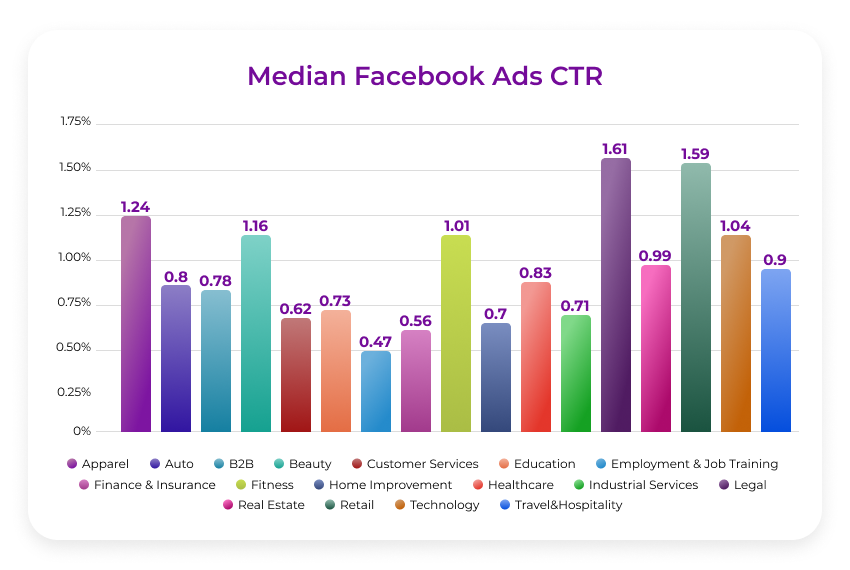
Then, focus on your business goals, which will determine every step of your advertising campaign creation. If your main aim is to boost brand awareness, your ad copy should be designed to catch the attention. The call-to-action is also defined by your goals; for example, it can urge users to contact you or learn more.
You can also try offering free trials or demos, depending on your industry. For secondary conversion, make sure you've created a separate set of ads dedicated to a specific action. The offer should be clear and appealing so the prospective client can make an immediate decision.
2. Know your target audience
As with many other types of programmatic advertising, the first and foremost step to increase the average click-through rate is to get to know your target audience. This group of people shouldn't be too broad so that the message you are trying to communicate can be easily aligned with it.
Sometimes other metrics can help — take a look at your most active website users or revisit your typical buyer personas to get a better insight into what your potential customers might like the most. To reach these groups, use targeting and retargeting options — you can segment users by devices, geolocation, age, and gender, as well as their customer journey stage.
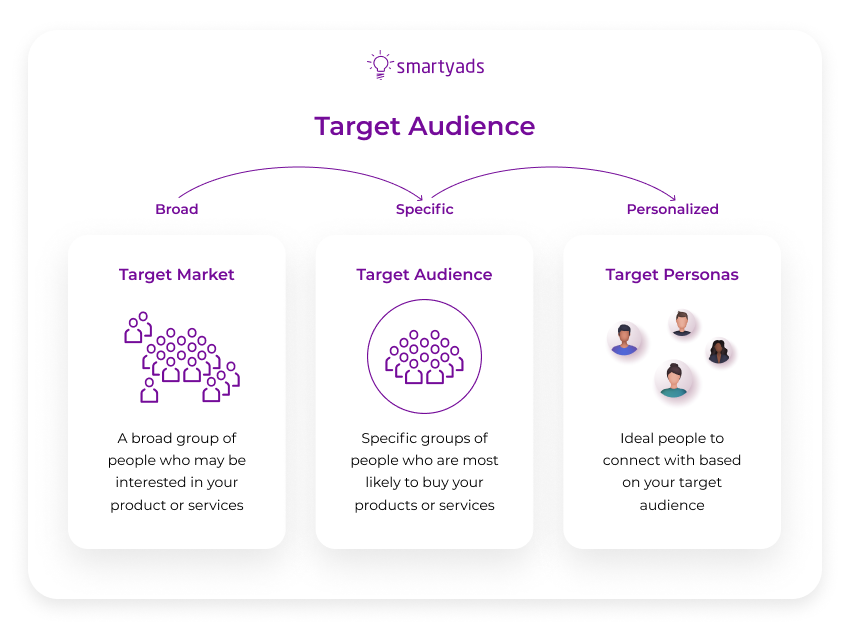
It is often a small detail that defines the success of the whole campaign, and picking the right keys directly reflects your understanding of the audience. How would they describe what they are searching for? What is most important for them? Where could they be looking for it? The use of specific language in your ad copy, the design of your creatives, its style — ideally, all these little things should align with your audience's interests and preferences.
3. 'Talk' to your audience
If we are going to get really serious about improving CTR, it is not enough just to briefly encounter your audience and learn a couple of facts about their interests. The most engaging ads are 'talking' to the target audience persona — use in your ad copy the words and phrases your ideal customers would use, dive into their jargon, and answer the questions they would ask.
Think about things they would consider the most appealing, or review your previous best-performing ads for inspiration. Working on your ad copy can significantly increase the CTR of your ads, especially if it's backed up by in-depth audience research.
Ensure that your ad copy remains compelling, clear, and user-focused. Strike a balance between incorporating keywords and delivering a persuasive message encouraging users to act. Regularly monitor and analyze the performance of your ad copy to make data-driven optimizations for desired results.
4. Keywords are the key
Apart from targeting your audience with personalized content, it is also essential to adjust the keywords on your landing pages. This will help users to navigate around your offers and can even increase your website visibility for search engines.
Remember that a specific product, service, or web page is easier for your customers to find by specific keywords. Narrow down their search to the exact offer you are going to present — this will save time and money both for you and your customers.
While this may lead to a reduction in an overall number of impressions or clicks — the CTR is actually getting higher, as your offers are now going to be targeted much more precisely.

5. Get around ad blindness
Banner blindness or ad blindness is a typical phenomenon when a user's brain learns to ignore advertisements, especially banner-like ones.
It's quite logical — after all, website visitors usually aren't primarily interested in advertising, but this factor can significantly affect your CTR and, consequently, revenue. What can be done to improve the click-through rate considering this phenomenon?
Well, some advertisers believe the more vivid the ad is, the more clicks it will get. The reality, however, proves that things are not so simple as, in many cases, ads are too colorful and are immediately labeled as 'banner noise' by our brains. The answer here lies in merging your message with the website's content.
For example, native ad formats often get higher CTRs because they easily adjust to the environment they're posted in. Try experimenting with different formats and sizes, change color schemes, and, most importantly, pay attention to the context.
6. Use Search Ads
Embracing search ad group can prove to be a powerful strategy in boosting Click-Through Rates (CTR) for your ads.
Tailored to the user's specific search intent, Google Ads often yield a higher CTR than other advertising tools. Leverage Google Ads ad extensions for increased ad visibility and appeal, and focus on compelling ad content and relevant keywords for optimal results.
The performance of your CTR is contingent upon the specific niche you operate within. Niche intricacies play a significant role in shaping CTR outcomes.
For instance, advertising smartphones amidst intense competition may result in a relatively lower CTR. In contrast, promoting cargo cranes may yield a higher CTR due to lower competition within the niche.
Even though users have largely gotten used to the presence of search advertising, it is still highly relevant and brings a large number of clicks.
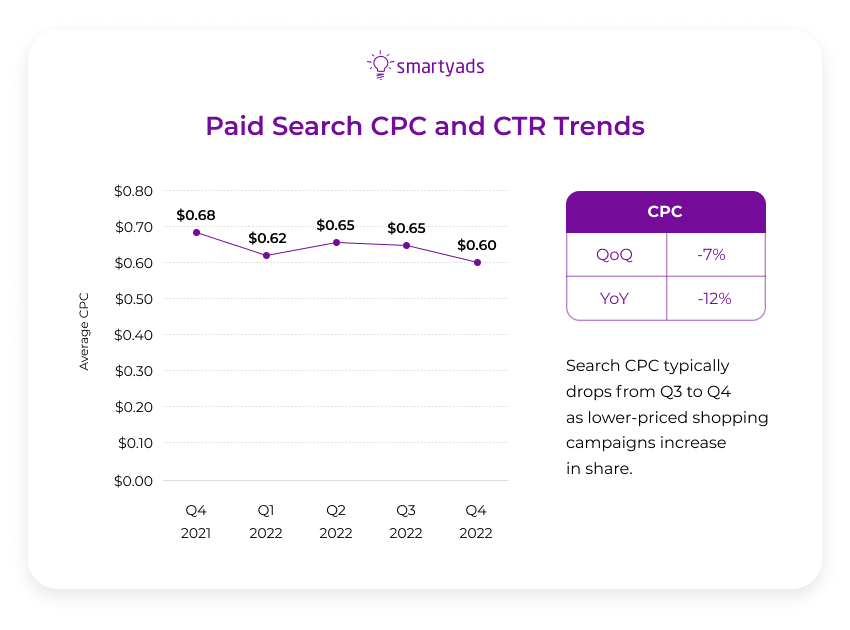
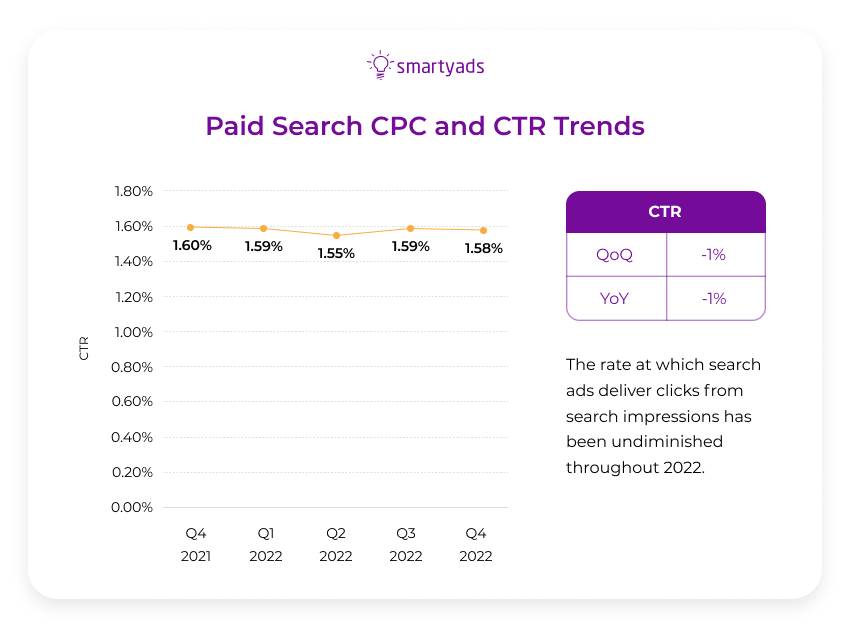
By strategically leveraging search advertising, you can unlock the potential to connect with a highly engaged audience and secure an impressive CTR for your search ads. Understanding the dynamics of your niche and adjusting your approach accordingly will empower you to optimize results and make the most of this valuable advertising tool.
7. Don't forget about Search Engine Optimization
When it comes to SEO, Click-Through Rate (CTR) holds a pivotal role in determining a website's visibility and impact. Studies reveal that the positioning of a website directly influences its CTR. Impressively, the first three search engine results capture a staggering 50% of clicks, with 28% of users clicking on the first link alone.
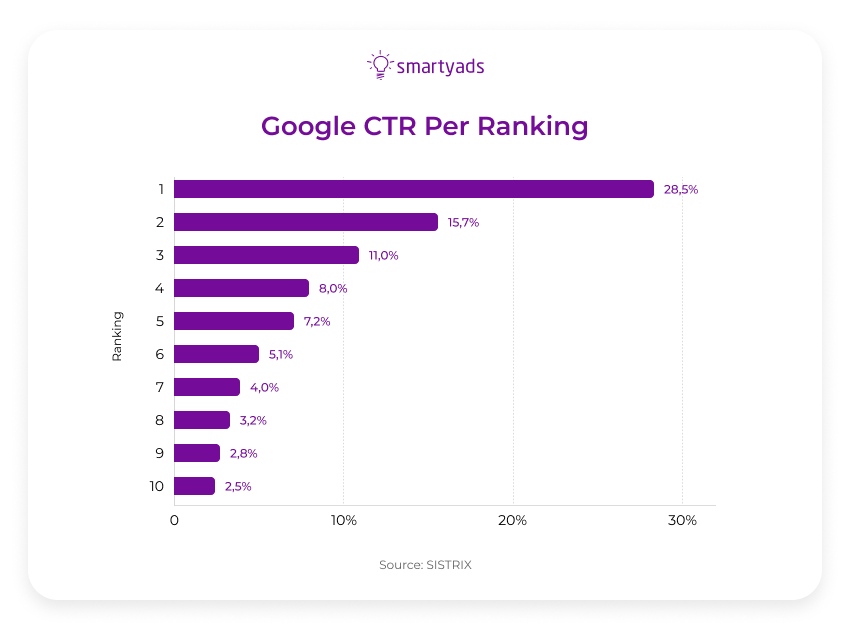
Notably, websites displayed on branded queries boast some of the highest CTR. This phenomenon highlights the significance of establishing a strong brand presence in garnering user interest and generating clicks.
As we navigate the realm of SEO, we mustn't overlook the influential connection between CTR and search engine result rankings. Strategic SEO endeavors and a focus on enhancing CTR can propel websites to the top positions of search results, allowing them to seize users' attention and maximize their online impact.
The main conditions for creating a competent SEO strategy:
- Make a list of competitive, high-quality, but not too specific queries;
- Prepare high-quality content both on the main site and on third-party sites;
- Develop a strategy of internal linking and attraction of external links;
- Fill in meta tags for your landing pages: meta title tag and meta description tag. The meta title tag should be no longer than 60 characters, and the meta description tag should be no longer than 160 characters.
8. Test and experiment
Probably one of the exciting things about the digital advertising industry is that there is no universal set of rules that would equally work for everyone.
So, never underestimate ad campaign testing. Each business owner, sooner or later, establishes their own approach, and even then, their strategy remains subject to constant changes. The only way to decide which practices are worth investing in is to constantly experiment and improve your advertising.
Start with making several different creatives and have a look at general patterns, notice and analyze which of them performed best and why. If you have some time, you can also research different formats and how they work for your business.
After choosing the most successful creatives, try using A/B testing to figure out what impacts your CTR the most. Wording and punctuation, using symbols or numbers, the color scheme of your creative — this can be something you wouldn't even expect. Implement the changes, test the results, and continue experimenting until you get what you want.
Make the most of the opportunities your advertising platform gives you, whether it's Google Ads or another programmatic platform.
Closely monitor the statistics of your advertising campaign after launch. If some of the ads get fewer clicks, then try changing different details in accordance with your findings. If this does not help, stop this ad so that it does not spoil the overall CTR.
9. Optimize for mobile
If your ads aren't optimized for mobile ad formats, chances are that many users simply cannot see them. Not only should they fit the format and work properly, but it is also crucial to consider what your ad will look like on mobile devices.
Check your titles and descriptions, creatives sizes, and the general appearance of your ads. They should be as accessible and appealing on mobile as they are on the desktop if you don't want to lose your potential customers.
10. Review your competitors' strategies
If you've already tried and tested most of your hypotheses but still want to increase CTR even more, it is time to take a look at your competitors. Their marketing efforts can have different success rates, but looking from a user's perspective can give you lots of insights.
Study search results on your most relevant keywords and analyze which ads perform best or get inspired by new unusual solutions. Not only can you come up with something new for your campaigns, but also you will be able to learn from others' mistakes, which is always smarter than making them on your own.
Conclusions
As we can see, there is no clear and inclusive strategy to increase the click-through rate for any company, but with some effort, it is not so hard to find out what works for your specific business needs. Take some time to analyze your existing campaigns and improve them.
If you haven't set up any campaign yet, use these practices to avoid common mistakes and apply them to your marketing efforts. At our DSP, you can have plenty of space for experimenting and picking up the best strategies, eventually leading your business to success and prosperity.
Beat your record CTR with SmartyAds — sign up at DSP today!

